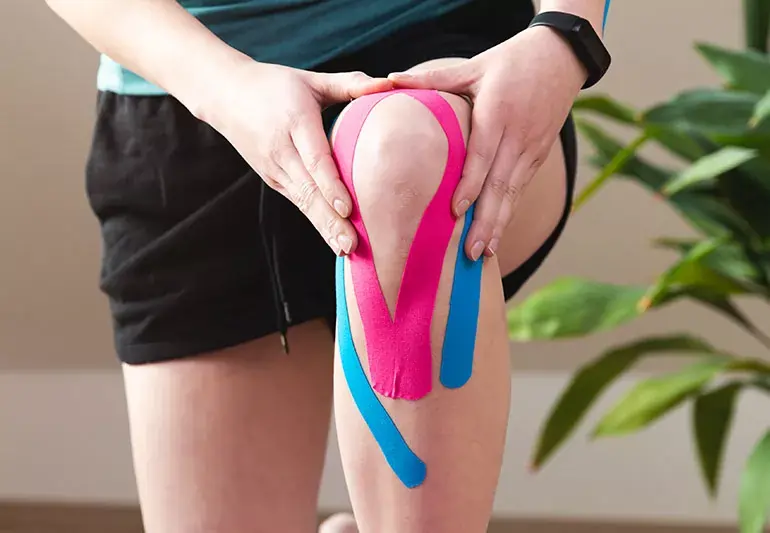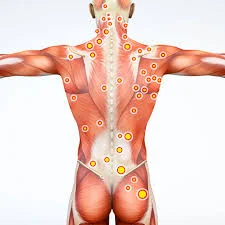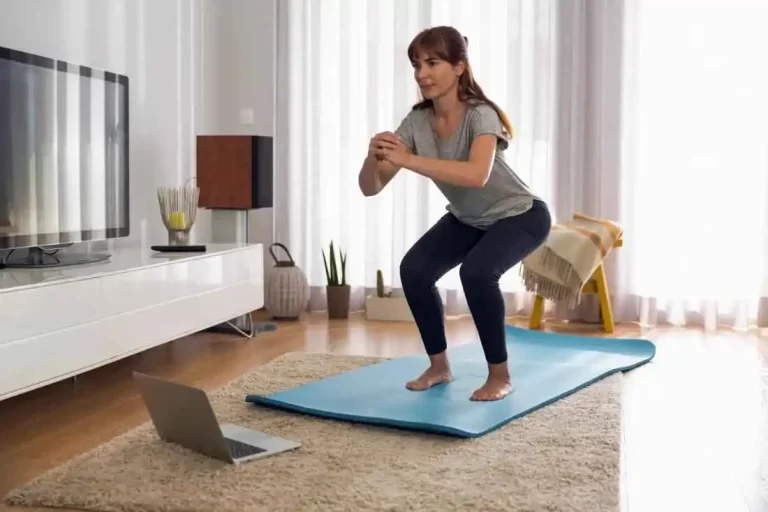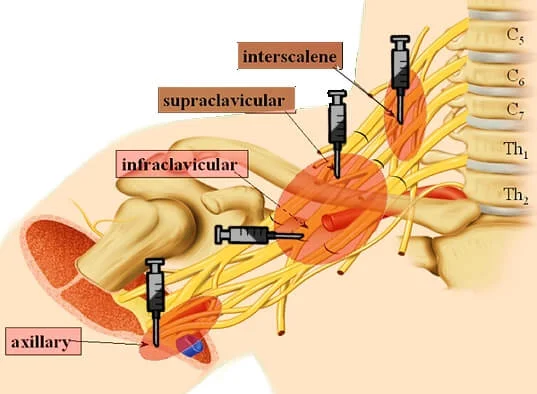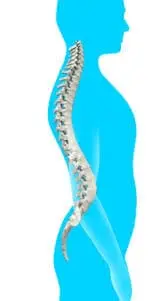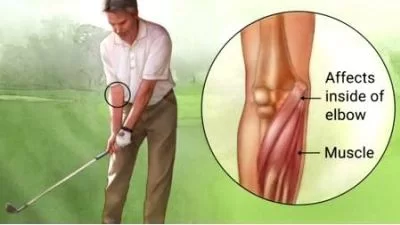Kinesiology Tape for Knee Pain
Introduction
Kinesiology tape is a stretchy, therapeutic tape applied to the skin to support muscles and joints without restricting movement. For knee pain, it can help reduce swelling, improve circulation, and provide mild support to stabilize the joint during activity. Often used in sports and rehabilitation, kinesiology taping can aid in pain relief and functional recovery.
Taping has a valid purpose in treating athletic knee injuries, but there is conflicting data on its use in enhancing lower limb biomechanics to lessen pain and enhance function in diseases like PFPS. From athletes to senior citizens, knee pain is a prevalent issue that impacts many different types of people. Some people use kinesiology tape, often known as KT tape, which is an adhesive, flexible tape, to treat knee pain and enhance function. It may be used to treat diseases like arthritis, trauma, and muscular imbalances that cause knee pain.
Whether you tap your knee to relieve pain, give stability, or treat a specific medical problem will determine how you do it. How you tape can also depend on the type of tape. To cure and prevent a variety of diseases, it is also used to increase knee support. See a sports medicine physician or physical therapist before attempting knee taping. It is used in addition to other therapies, such as NSAIDs and therapeutic exercise. Even if you have the same knee problem, a technique that works for someone else might not work for you.
Are you unsure about the best way to apply KT Tape to support your knee and treat knee pain? Applying Kinesiology Tape properly can have a significant impact on injury recovery, overuse pain management, and reducing strain during exercise. You will discover how to apply KT Tape for complete knee support in this guide, which will cover everything from how to bend the knee to where to put the tape and how much stretch to use. For athletes, runners, and anybody else experiencing knee pain, this method is perfect since it lowers pressure, stabilizes the kneecap, and encourages muscle healing.
Whether you’re in pain or recuperating from an injury, it can improve your capacity to exercise. It should provide support rather than restrict blood flow. These multicolored strips of elastic, permeable tape appear to provide therapeutic benefits when applied to affected areas of the body, based on anecdotal evidence.
What is Kinesiology Tape?
Usually, cotton or a fiber blend is utilized. When exercising or participating in sports, people usually wear the tape on their skin, usually around a joint or muscle.
Kinesiology tape is a thin, flexible tape created to help athletes use their muscles more easily and perform better. It is frequently used to support muscles and joints, lessen edema and inflammation, and relieve pain.
Kinesiology tape’s elasticity, or stretchiness, permits mobility. These are used to support and immobilize muscles and joints following sports-related injuries, as well as for individuals with conditions that impair muscular activation or contraction control.
- A person’s range of motion is unaffected by the tape’s flexibility since it does not limit the application area.
- In 1973, Japanese chiropractor Dr. Kenzo Kase created kinesiology tape. He reasoned that an outside element might help muscles and other tissues work.
- To prevent injuries and provide their muscles and joints with additional support when exercising, many athletes and sportspeople wear kinesiology tape.
How kinesiology tape works for knee pain
While offering support for your upcoming workout, KT Tape helps relieve strain on the tissue and may lessen pain in various knee locations. With the aid of these tools, you may choose the optimal approach for your needs and maximize the benefits of utilizing kinesiology tape for support and pain relief.
- Lowers pressure and inflammation by slightly elevating the skin.
- Improves circulation and lymphatic drainage.
- Provides support without limiting range of motion.
- Enhances proprioception (body awareness).
The following common knee diseases may benefit from KT Tape:
- Patellofemoral pain syndrome (runner’s knee)
- IT band syndrome
- Arthritis-related knee pain
- Ligament strains (ACL, MCL)
- Meniscus issues (minor)
- General overuse or instability
Osteoarthritis and Taping: Degenerative joint disease (DJD), often known as osteoarthritis, is a painful disease that affects a large portion of the elderly population. Unusual joint wear caused by lost cartilage and loosened ligaments can be severe enough to impair one’s capacity to perform daily tasks. Kinesiology tape has been demonstrated in studies to be useful in lowering knee pain and enhancing performance in activities like stair climbing. Additionally, studies indicate that kinesiology tape may be beneficial for those with arthritis in joints other than the knee.
Taping and post-operative healing: Major joint replacement surgery is frequently performed nowadays, and these are frequently the same joints that are prone to arthritis (shoulders, hips, knees, etc.). After that, the main goals of the healing process are to lessen pain, manage swelling, and increase mobility. Taping has been shown to enhance knee mobility and reduce edema and post-operative pain among individuals who have had total knee replacements.
Patellofemoral pain syndrome (runner’s knee): The most frequent cause of patellar tendon soreness is excessive use of the patellar tendon in sports. Another name for this is Patellofemoral Syndrome. This frequently comes with a sharp pain. If the patellar tendon is too badly injured, this pain may become chronic and increase in frequency over time.
IT band syndrome: The process of using kinesiology tape to decompress the region. You might find that tape helps ease your pain.
- Applying tape in various directions will raise the skin and aid in decompression. Could you get three short I-strips ready? The goal is to raise the skin and aid in decompression by applying tape in various directions.
- A ten percent strain is applied to the first strip. Over the hip bone, place it. Then, put your second strip in the shape of an X over the first strip. Place the third strip on the very top of the first two after that. Ten percent tension should also be applied to these two strips.
- After that, the tape needs to be cut and measure from the hip to the knee.
- Hold the leg out in a stretched position. Remove the tension from your final strip and taper.
- Remember to smooth your edges at all times. Rub the tape in to get the strongest possible adhesion.
The Advantages of KT Tape for Knee Pain
It’s crucial to comprehend what it is and how it helps people with knee pain before applying. It is additionally referred to as kinesiology therapeutic tape. Pain is lessened by this mild lifting movement, which also encourages healthy blood circulation and lessens pressure on the injured area.
- Reducing edema may be assisted by increasing lymphatic drainage.
- Through improved muscle coordination and stability, this improved proprioception can reduce the possibility of further injury.
- Pain reduction
- Increased mobility
- Non-drug pain management
- Can be worn during activity and exercise
How to stabilize an unstable knee?
- The methods listed below are typically used to address conditions like patellofemoral disorders or overuse injuries. By improving knee stability, they can also aid in preventing further injuries.
- The knee should be supported by the taping, but it shouldn’t be too tight to prevent blood flow.
With kinesiology tape for full kneecap support
Sports tape with a lot of stretch is called kinesiology tape. It is believed to offer support by keeping muscles and joints stable. Overuse or patella tracking dysfunction may be the cause of the disease, commonly referred to as “runner’s knee.”
Supplies:
- Kinesiology tape
- Scissors
- Clean skin
To apply knee tape:
- Measure from your quadriceps tendon to the tibial tubercle, which is the bulge beneath your kneecap. Cut two equal lengths of tape. To reduce peeling, round the ends.
- Bend your knee while sitting on a bench. Peel one strip’s first inch. Make sure to secure outside the tibial tubercle without stretching.
- The tape should be stretched to 40%. Follow the inner knee’s natural bend when wrapping the tape around it. Without stretching, secure the end.
- A piece of tape that will fit under the kneecap should be cut. Raise your knee a little.
- From the middle, remove the tape. For more specific information, see the product’s box.
KT Tape Application for complete Knee Support
 KT-Tape-Application-for-complete-Knee-Support
KT-Tape-Application-for-complete-Knee-Support
Applying tape to an elbow or knee while it is fully extended increases the likelihood that it will come free or peel off as the joint moves. As the joint flexes, the tape will stretch and become less sticky. The Kinesio knee tape should never have its beginning or last two inches stretched on either end. KT Tape can be used to support your knee, reducing pain and offering stability while you move. To properly apply two complete strips of tape to the whole knee, follow these steps:
This posture aids in guaranteeing correct tape positioning and adherence.
The first strip
- Using one end of the backing paper, pull off about 2 inches to construct your anchor.
- Don’t stretch; put this anchor right above the kneecap.
- Secure the strip’s left end.
Second strip:
- On the other side of the kneecap, repeat the same procedure.
- Secure the first end without any stretch, wrap the kneecap with tape that has a modest amount of stretch, and then secure the last anchor without any stretch.
Last step:
- Adhesive tape must be activated by applying constant pressure and heat to ensure it adheres well to skin. Adhesion can be enhanced by rubbing or smoothing the tape after application to ensure complete skin contact and reheating the adhesive.
Self-taping instructions for non-professionals
- Bending your knees when lying down helps ease pain, lessen pressure points, and increase blood circulation. Strength and range of motion can be enhanced by sitting with the knee bent.
- Don’t pull on the tendon beneath the kneecap as you finish by bringing the ends together.
- Another Y-tape is utilized to increase support and enhance functionality.
- On the top portion of the lower leg, place the tape’s base on the bony bulge beneath the kneecap. Slight stretch around the kneecap, placing one strip on the outer side and the other on the inner side, both of which should follow the length of the kneecap.
KT Tape Application for Inner Knee Support
 KT Tape Application for Inner Knee Support
KT Tape Application for Inner Knee Support
Knee position: To maintain the area loose and accessible for tape, slightly bend your knee.
First strip:
- Without stretching, position this anchor on the inside of your leg, right below the knee.
- After removing the remaining backing, put the strip across the sore area using a moderate amount of stretch.
- Lay the strip’s end just past the outer knee, without any stretch, to finish.
Second strip:
- Apply this anchor without stretching, immediately above the first strip.
- The center portion of the backing should be peeled off before applying it with a reasonable amount of stretch, angled across the knee, and crossing over the first strip at the area of pain.
- Don’t strain when applying the last attachment at the end of the tape.
Last step:
- Tape is activated, and a secure bond is ensured by gently stroking it, which improves adhesion and creates a stronger seal. This stage is essential for several applications, including athletic tape, medical dressings, and even cosmetic applications like facelifting tape.
KT Tape Application for Outer Knee Support
 KT Tape Application for Outer Knee Support
KT Tape Application for Outer Knee Support
For pain on the outside of the knee, which is frequently caused by IT band syndrome, overuse, or bad training habits, this taping technique is perfect. KT Tape improves circulation, eases pressure, and relaxes surrounding muscles. This is how to use it:
Prepare the area:
- Wash your skin to get rid of any oils or lotions.
- To increase the tape’s adherence, cut hair if needed.
- Avoid tearing the tape when dressing.
Position the knee:
- You can either sit or lie down to get your knee at a 90-degree angle. Make sure your thigh forms a 90-degree angle by keeping it parallel to the floor.
First strip (cut in half):
- Find the area where your knee hurts by bending it to about a 90-degree angle.
- Avoid coming into contact with the adhesive.
- When a strip has 80% stretch in the middle, the middle part of the strip usually receives that degree of elongation or stretching, while the edges receive little to no stretch.
- Don’t strain when applying the ends.
Second strip (other half):
- Pull the paper’s outermost layer from the center once more.
- Apply this strip vertically beneath the area of pain, making an “X” shape with it by crossing the first strip.
- Especially when it comes to the “anchor-stretch-anchor” technique. By lifting the skin, this method can produce a therapeutic effect, like better circulation or pain reduction.
Third full-length strip:
- Without extending, place the anchor in the middle of the “X.”
- After removing the remaining backing, apply it with a 25% stretch, bending it around the knee.
- Finish without letting the end stretch.
Last step:
- To activate the glue, rub the entire taped area; a little heat increases stickiness.
KT Tape Application for Back of the Knee Support
 KT Tape Application for Back of the Knee Support
KT Tape Application for Back of the Knee Support
By gently stabilizing the muscle and easing stress over the back of the leg, this taping technique aids in hamstring support. Use two strips of KT Tape and proceed as follows:
First strip:
- This produces a tiny, adhesive-exposed area that can serve as the tape’s application starting point. On the outer calf without any stretch, position the anchor directly below the rear of the knee crease.
- When the leg is stretched, either standing or lying down, measure the amount of tape required to correctly tape the back of the thigh with a small stretch. The tape’s end should be placed just below the knee joint on the outside of the lower leg. Next, put the tape to the upper portion of the back of the thigh, just below the buttock, with a modest stretch (about 10%), bending the hips and extending the knee. Peel off the middle backing.
- Without stretching, lay the tape end down. This keeps the tape from pulling off or wrinkling and helps it stick completely.
- To release the glue and get rid of any creases or air pockets, gently touch the tape with your fingertips.
Second strip:
- In the same manner, make an anchor by tearing it two inches from the end.
- Without stretching, place the anchor on the inner calf beneath the knee crease.
- The other end should be laid flat.
- To ensure complete adherence, straighten the leg and press the tape into position.
Various taping methods for different types of knee pain
General taping techniques:
- Y-strip for patella tracking
- I-strip for stability or pain relief
- Fan shape for swelling
Although a basic taping technique was discussed in the previous section, it’s important to remember that different types of knee pain may call for different taping methods. Here are a few instances:
- Applying tape around the patella with the ends secured above and below the kneecap is a popular method that helps increase blood and lymphatic flow by producing a lifting effect.
- Support for the Medial Collateral Ligament (MCL): Taping is frequently used to maintain the medial collateral ligament following an injury, especially when returning to sports. This approach has no research to support it, despite anecdotal evidence. To support the lateral aspect of the knee, for instance, in cases of LCL injury, the same approach can be used.
- Iliotibial (IT) band syndrome: A common running disease called iliotibial (IT) band syndrome can be supported and pain managed with KT tape, also known as Kinesio Tape. It may offer momentary respite during and after running, but it won’t treat the disease or its recovery. When using tape correctly, the “anchor-stretch-anchor” technique should be used, the tape should be applied with a reasonable amount of stretch over the sore area, and the ends should be tightly secured.
To find the best taping method for your particular problem, it’s crucial to speak with a medical expert or physiotherapist.
How to remove kinesiology tape
Knee tape has a good ability to stick. Think about the following ideas when it’s time to remove it:
Tips for removing kinesiology tape
- Put some oil on it. After applying oil on the tape and letting it sit for 15 to 30 minutes, rinse it off in the shower.
- Roll the tape off. Rolling is less uncomfortable than pulling.
- Proceed in the hair’s growing direction. Your skin and hair follicle irritation is reduced as a result.
- Pull the skin. Oppositely pull the skin with your other hand as you peel off the tape. It is claimed that this lessens pain.
Dos and Don’ts
Do’s:
- Before applying, round the edges of each strip. This reduces the risk of the corners of the tape pulling up too soon.
- Make sure the tape adheres securely in place by rubbing it to activate the adhesive.
- Any thick hair should be cut off or removed if you intend to tape that area of the skin. Long or thick hair may make it difficult for the tape to adhere well to the skin, but fine hair shouldn’t be an issue.
Don’ts:
- It is not advisable to apply kinesiology tape immediately following physical activity or a shower.
- This means that cuts, rashes, and sunburns shouldn’t be covered with tape. When applying the tape, try not to come into contact with the adhesive side. Apply the last several inches of tape on either end without stretching at all, and just fully extend the middle portion.
Limitations and Risks
There are drawbacks and possible hazards when using kinesiology taping (KT) for knee pain. Although some people find it useful for reducing pain and enhancing function, evidence does not always support its efficacy. Not all people or conditions can benefit from it, and proper application might be complicated.
Limitations
- Limited Effectiveness: According to research, not everyone with knee pain will experience significant or long-lasting alleviation from KT.
- Lack of Individualization: Since KT is a generic product, it might not be able to address the unique circumstances or causes of each person’s knee pain.
- Dependency: Using KT alone to treat knee pain may stop research from looking into other therapeutic options.
- Cost: Over time, buying and replacing KT might get pricey.
- Incorrect Application: To guarantee correct application, patients may want expert advice.
Risk
- Skin Irritation: Wearing the tape for long periods or under excessive tension might irritate the skin, particularly if it is contaminated by perspiration.
- Contraindications: Areas with open wounds, infections, or damaged skin should not receive KT application.
- Deep Vein Thrombosis (DVT): Avoid KT near a DVT, as it may cause a clot to come loose.
- Other conditions: People with heart problems, renal insufficiency, or other illnesses must be taken into account.
Is taping a new approach?
The use of tape is not new. Athletes who lift weights, play volleyball, climb rocks, and dive have also long used them. As early as 1969, the idea of using tape for support and injury prevention was mentioned in the literature, but Kinesio taping (KT) is a relatively new technique that was created in the 1970s. For many years, to stabilize joints and stop more damage, rigid taping has been utilized.
Conclusion
- Whether you’re in pain or recuperating from an injury, it can improve your capacity to exercise. It should provide support rather than restrict blood flow. They can demonstrate the most effective method and use for your problems.
- Although KT might be helpful for knee pain, it’s not a panacea. There are some hazards and restrictions to take into account, especially for those with particular diseases or sensitivities, and its efficacy is not entirely demonstrated.
Knee taping can provide comfort when paired with a therapeutic exercise regimen.
FAQs
For knee pain, what kind of tape is used?
Effective Knee Taping Methods for Pain Reduction and Stability
Knee stability is successfully achieved with the Kinesio taping technique while preserving a healthy range of motion. This method, which is perfect for athletes and those who need support during physical activity, uses flexible elastic tape to support the knee without limiting movement, unlike stiff taping methods.
Which is better, KT Tape or a knee brace?
While Kinesiology Tape’s flexibility allows for a full range of motion and may be appropriate for less severe injuries, orthopedic supports often offer a higher degree of support and stabilization. Regardless of the choice, the objective is to assist your body, encourage recovery, and stop additional harm.
Can I use KT Tape to take a shower?
How to handle a wet tape situation. There is no need to be concerned about getting your tape wet. Because kinesiology tape is water-resistant, you can swim, take a bath, or shower while wearing it. You can use a towel to gently pat the tape down after engaging in activities that get it wet.
Can KT Tape be reused?
Not every K-tape is made equally. While some brands sell tapes that are made just for one use, others offer tapes that are meant to be used repeatedly. To find out if a specific tape is reusable, it’s important to read the manufacturer’s instructions or speak with a healthcare provider.
Reference
- Nunez, K. (2019, December 20). Four techniques for knee taping. Healthline. https://www.healthline.com/health/how-to-tape-a-knee
- Kylejohnson. (2025, April 23). How to use KT tape for knee pain. Arthritis Knee Pain Centers. https://arthritiskneepain.com/wellness-blog/kt-tape-for-knee-pain/
- Rowden, A. (2024, January 26). Can kinesiology tape help knee arthritis? https://www.medicalnewstoday.com/articles/kt-tape-knee-arthritis#dos-and-donts
- Ocs, J. C. P. D. M. (n.d.). Kinesiology Tape: What it is and How to Use it. Hospital for Special Surgery. https://www.hss.edu/article_kinesiology-tape.asp
- Admin, & Admin. (2019, July 29). Is kinesiology tape effective for knee pain? – Colorado Center of Orthopaedic Excellence. Colorado Center of Orthopaedic Excellence. https://ccoe.us/news/is-kinesiology-tape-effective-for-knee-pain/
- Australia, T. (2025, February 21). How to tape knee pain. THYSOL Australia. https://www.thysol.com.au/how-to-tape/knee-pain/?srsltid=AfmBOopCYKdJN0XwzjYoxSZbvgbvCBZtEgbhDmpkiTsxZwwVkuR7LZv-

